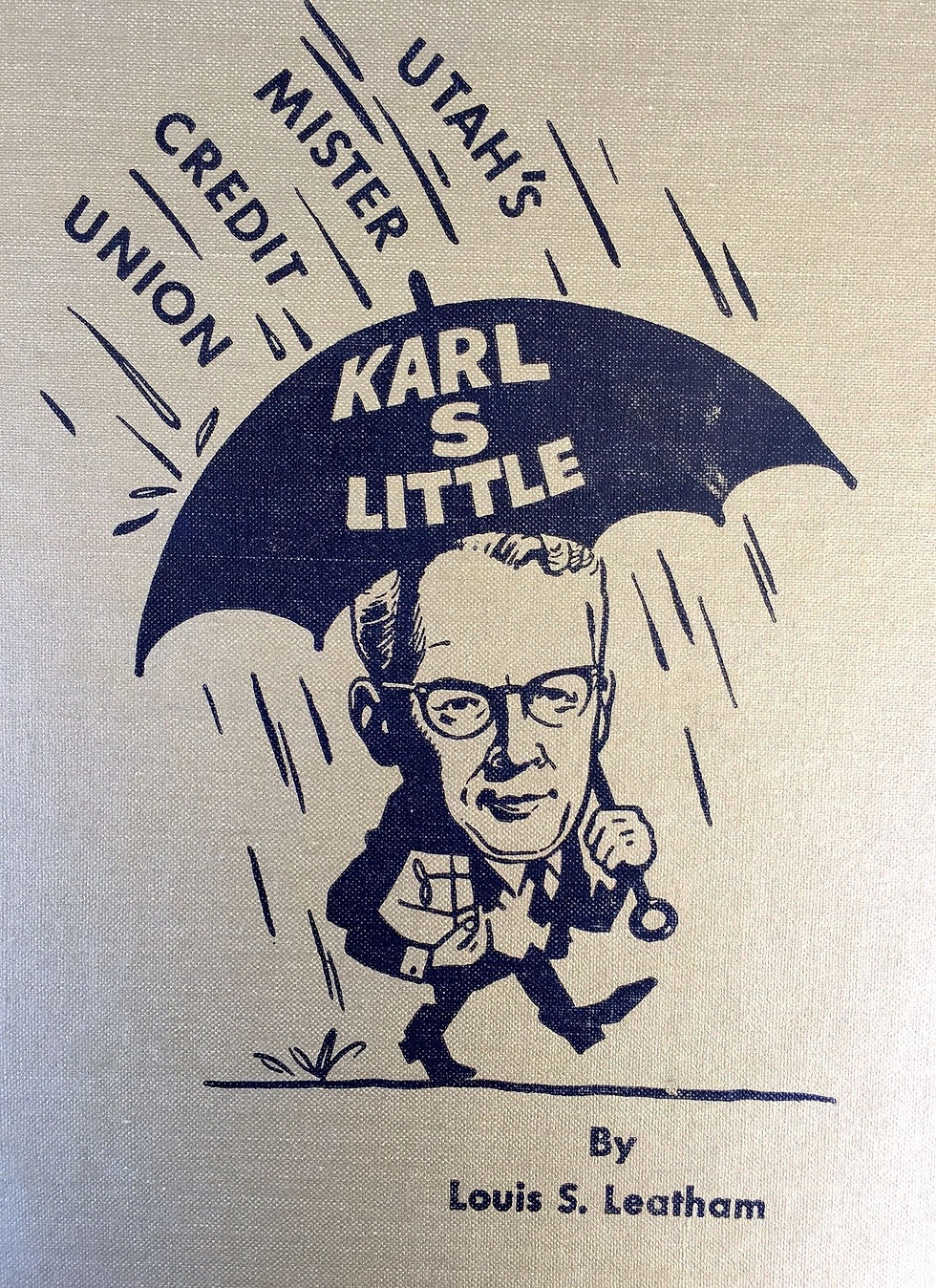Hannibal native remembered as ‘Utah’s Mr. Credit Union’
- Mary Lou Montgomery

- Jul 1, 2016
- 4 min read

This is the cover of the book featuring the life and career of Karl S. Little. (Contributed by Del Anderson of Ogden, Utah)
MARY LOU MONTGOMERY
Salt Lake City, Utah, in the spring of his manhood, when he found himself short on cash. He naively borrowed $200 from what turned out to be a predatory lender, and made payments for a year before realizing he had only paid interest on the loan, and the principle was still outstanding.
The experience provided a valuable lesson to Little, and sparked the notion in his mind that there must be a better way for wage earners to manage their money.
Thanks to the work of the Credit Union National Extension Bureau, the Utah State Legislature passed effective credit union legislation in 1928, and Little jumped upon the Credit Union bandwagon. His goal was to ensure that other wage earners wouldn’t fall victim to unscrupulous lenders as he had during his early manhood.
For the next decades, Little championed the cause of fair and just money management options for workers, and ultimately, he was dubbed “Utah’s Mister Credit Union.” A book by that name, written by Louis S. Leatham, was published by Edwards Brothers Inc., Ann Arbor, Michigan, in 1963.
Mr. Leatham wrote in the book’s first chapter: “Hundreds have added their names to the growing scroll of honor of those who have given dedicated service to their fellowmen through the credit union movement. But among the greats, the leaders, those who have served unselfishly for a lifetime, are an especially honored few. And among this group, the name of Karl S. Little is prominent.”
In September 1965, Little was introduced as the main speaker for the open house of the Railroad Employees Federal Credit Union in Pocatello, Idaho. The Idaho State Journal of Sept. 5, 1965, noted that Little had 46 years of service with the Union Pacific Railroad, with 12 of those years working fulltime with the Brotherhood of Railway Clerks. He was legislative coordinator of the entire labor movement in Utah from 1938 to 1952, organizer of the Salt Lake area United Fund and a member of its the board of directors.
Hannibal
Born in March 1898, first child of William Archibald Cooper Little and his wife, Ida Bell Fritz Little, he spent his early years living in a small bungalow on Broadway Extension with his parents and widowed grandmother, Mildred Kathryn Curts Fritz.
His father, nicknamed Arch Little, was an iron molder who worked alternately between Hannibal’s two stove companies. He moved his family several times during Karl’s educational years, from 1554 Broadway, to 1252 Lyon, then to 1258 Lyon and finally to 223 Lindell.
Karl graduated from Hannibal High School in 1916. About that time, his parents settled in a second-floor apartment at 304 ½ Broadway – upstairs over the Klines’ Department Store. Arch Little was a local musician of note, and an officer in the molders lodge, which had its hall on the building’s third floor.
Karl got a job as a railroad clerk, married his 17-year-old high school sweetheart, Helen Viola Gould Alden on April 11, 1917, and set up housekeeping with his bride at 918 Lindell Avenue. About a year after their marriage, Karl Little was working as a stenographer with the Missouri, Kansas and Texas Railroad in Hannibal. Louis S. Leatham described what followed: “His yardmaster asked Karl to write a letter of inquiry to Salt Lake City to see if there were any yardmaster openings in the Union Pacific Railroad Company. On a sudden impulse, Karl added a P.S. to inquire as to the need for clerks. The letter of reply indicated no openings for the yardmaster but there was a clerical position available. Karl followed through and got the job.”
Extended family
About the same year that Karl married Helen, his mother, Ida Belle Fritz Little, gave birth to her third child and first daughter, Kathryn. While a generation apart in age, the lives of siblings Karl and Kathryn would intertwine throughout the years.
While Karl and Helen moved to Utah, Hannibal served as a happy and financially fit place for Arch and Ida Belle Little to raise their daughter Katherine, with plenty of friends, family and dance venues to make life interesting.
Kathryn’s son, Del Anderson of Ogden, Utah, remembers his uncle fondly. Del said that it was Karl Little who enticed his parents to Utah during the years of the Great Depression.
As money became scarce for the Little family in Hannibal, Karl invited his parents and grandmother to move west. They lived with Karl for awhile, then set out on their own. Karl helped his father find a job as a security guard, and he remained in that line of work until his retirement.
Credit union
Surrounded by family in Utah, Karl pursued the credit union cause in earnest.
• He organized the Utah Credit Union League in 1935, and served as its managing director for more than 30 years.
• He served as treasurer-manager of Utah Central Credit Union, was a national director of the Credit Union National Association for more than 25 years, and also served as its vice president and secretary.
• Under the direction of Karl S. Little, the credit union membership grew to 50 percent of the population of the State of Utah.
Karl S. Little died Jan. 29, 1983, followed in death by his wife on Jan. 27, 1988.




























Comments